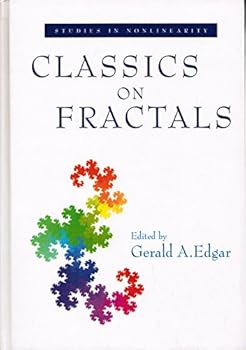Classics On Fractals (Studies in Nonlinearity)
Select Format
Select Condition 
Book Overview
Fractals have recently become an important topic of discussion in such varied branches of science as mathematics, computer science, and physics. Accordingly, there is an interest in the mathematical underpinnings for a (yet to be realized) theory of fractals. Classics on Fractals collects for the first time the historic seminal papers on fractal geometry, dealing with such topics as non-differentiable functions, self-similarity, and fractional dimension. This compendium is an invaluable reference for all researchers and students of fractal geometry. Of particular value are the twelve papers that have never before been translated into English. Commentaries by Professor Edgar are included to aid the modern student of mathematics in reading the papers, and to place them in their historical perspective. The volume contains papers from the following notables: Cantor, Weierstrass, von Koch, Hausdorff, Caratheodory, Menger, Bouligand, Pontrjagin and Schnirelmann, Besicovitch, Ursell, Levy, Moran, Marstrand, Taylor, de Rahm, Kolmogorov and Tihomirov, Kiesswetter, and of course, Mandelbrot.
Format:Hardcover
Language:English
ISBN:0201587017
ISBN13:9780201587012
Release Date:August 1993
Publisher:Addison-Wesley. Reading, Mass
Length:384 Pages
Weight:1.50 lbs.
Dimensions:9.5" x 0.8" x 6.5"
Related Subjects
Geometry Math Mathematics Science Science & Math Science & Scientists Science & TechnologyCustomer Reviews
2 ratings
The Laying of Cornerstones of Modern Math
Published by Thriftbooks.com User , 20 years ago
The title of this book is subversive. Compared to the contents of other popular books on fractals, such as Peitgen & Saupe's "Chaos and Fractals", the reader will find almost no commonality except for the word "fractal" in the title. And this is what makes this book so wonderful and refreshing. Other pop books on fractals tend to be filled with shallow descriptions, crude phenomenology, and neither hint of the underlying theory, nor any clue of the depth and importance of it. The Peitgen-Saupe series is particularly guilty of this fault. By contrast, in this book, "Classics on Fractals", we hear Georg Cantor explain Cantor sets in his own words, and realize how trivialized the pop-lit explanations are. We have Helge von Koch explain the Koch curve, and Felix Hausdorff explain Hausdorff measure; Besicovitch explaining fractal dimensions, Paul Levy presenting fractals that tile (now called Levy dragons), and Kolmogorov theorizing about entropy. The papers reproduced in this book are fifty to one hundred years old: we catch glimpses of the cornerstones of modern mathematics being laid. Note, however, that you will need to have strong mathematical skills and interests to find the pleasure and entertainment in this book. This is, after all, a collection of mathematical papers written by leading mathematicians, for other mathematicians, and originally published in mathematical journals. These are not simplified expositions for the lay reader. Each non-English reprint has been translated to English, and is preceded by several paragraphs of introduction to the setting and the mathematician. Serious amateurs investigating fractals will be awed by this book, and professionals will be a bit humbled on rediscovering some of the history of fractals.
Where it all began
Published by Thriftbooks.com User , 25 years ago
This anthology is a collection of the classic essays on chaos, from before chaos theory was created or the word 'fractal' was coined. The math level is a little high for the general reader, but it is well worth reading once the reader has the necessary background.






